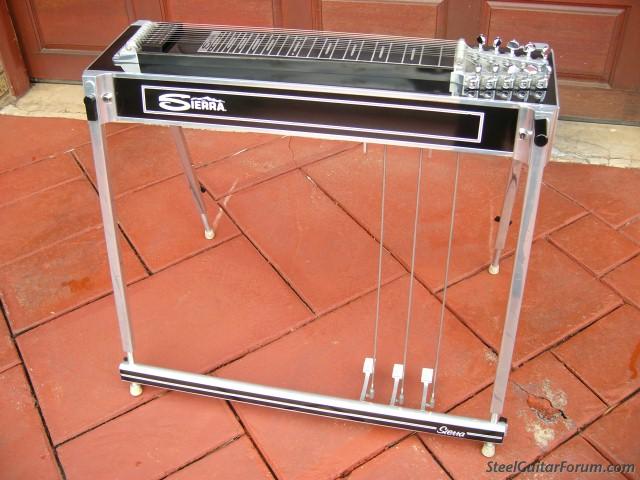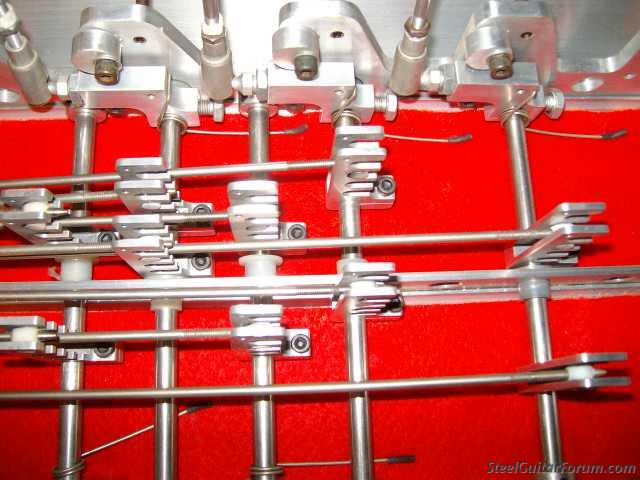Page 1 of 1
Ode to my Sierra S 10 and band picture
Posted: 20 Jan 2013 9:53 pm
by Jan Viljoen
Music is the universal language of the world.
And the world has come a long way from the first single string instrument about 10 000 years ago.
In a nice gesture the South African Vienna State Opera diva, Mimi Coertse renders a song about the one string ramkietjie, with the link hereafter.
http://www.youtube.com/watch?v=tFKyTu3VBok
Then, on my way to Nirvana, my path crossed that of a metal music machine, which I could not pass. I picked it up on Saturday, with books, picks and a bar.
The first owner did not have the time to practice, and the second plays bass and harmonica in a church band.
This black Sierra is a 3x4 and in very good condition, the underside looks just like the day
it left the factory.
I reckon it does not have more than 300 hours on the clock.
It has an original humbucker, but I also have an extra Wallace truetone pickup.
I would have liked a red machine, but this one looks just as good.
I give credit to the Steel guitar forum and all the formidable forumites to learn from.
I also thank Neil Flanz and Lane Gray.



Model?
Posted: 5 Feb 2013 4:09 am
by Jan Viljoen
Hi Folks,
Can somebody tell me what model I have, please.
I think it was built in '92.
And regarding pickups, how does one determine the properties of a pickup?
Is it all about the resistance/output or what?
Why are they wound to high resistances and a 6 string pup not?
Posted: 5 Feb 2013 4:56 am
by Joe Babb
Hello Jan,
That's a beautiful guitar you have there. Sorry I can't help with the model #. I'm certain someone here on the forum can identify it.
Pick ups are complex gadgets. They have resistance due to the amount of wire used to form the coil and also inductance and some distributed capacitance. They are hard to analyze because the coupling of the moving string in the magnetic field which creates current in the coil is hard to define. I'm guessing that a lot of experimentation goes into the design of one and a lot depends on the designer's ears.
Joe
Posted: 5 Feb 2013 10:17 am
by Ross Shafer
This just in from my pal Tom at Sierra:
"This is a "Royalty" series guitar. Built during the same period as the "Crown"
Note: Crown was defined by ( Gearless w/ 25" scale)
Geared guitars at that time were the Royalty
Last 2-digits of the serial # will tell you the year."
Posted: 5 Feb 2013 10:23 am
by Jan Viljoen
Thanks Ross and Joe, I take notice of your inputs.
The scale is 24".
Regards.
Posted: 5 Feb 2013 10:43 am
by Ross Shafer
you're welcome. Check out Sierra's website if you'd like to have much nicer leg swivel, height adjust and pedal bar knobs....those plastic ones are less than great.
http://www.sierrasteels.com/
Posted: 5 Feb 2013 11:34 am
by Hans Penner
Ross
I checked out your Sierra link and see only replacement pedal bar knobs.
Can't see where the other 2 items are to be had.
Posted: 5 Feb 2013 12:23 pm
by Ross Shafer
Hans,
On the Crown and Royalty guitars (and earlier models) the pedal bar knob and the rear leg height adjust knobs are the same thing. While there's three different things you need knobs for...there's only two different knobs.
Look a little closer at that pic on the Sierra home page and you'll see the first knob on the left is the old plastic "L-Knob" the knob to the right of that next to it is the new aluminum "L-knob" this is used for the leg swivels. The next knob in line is the old plastic "T-knob" and to the right of that is the new aluminum "T-knob" that is used for both the rear leg height adjustment and the pedal bar.
Posted: 5 Feb 2013 3:37 pm
by Hans Penner
Thanx, Ross.
Got it.
Pickup knowledge
Posted: 5 Feb 2013 10:23 pm
by Jan Viljoen
Somebody sent me this link regarding the properties of pickups.
It is very informative and I hope others may benefit from it as well.
http://steelguitarbuilder.com/forum/vie ... f=10&t=602
Stiff springs.
Posted: 28 Feb 2013 8:31 pm
by Jan Viljoen
I have been playing this music machine now for a while, and I found the pedals and levers are stiffer than my Stage One.
What can I do about it? Must the springs be played in, or what?
What metal mixture is the guitar made of? How much copper for sound, magnesium for hardness?
Thankz.
Jan
Posted: 1 Mar 2013 6:00 am
by Jim Pitman
The Ed Packard pickup explanation is quite comprehensive.
I thought I'd answer your question directly though about the resistance of a PSG pickup vs regular guitar.
It's quite simple - there are more stings/poles and one turn of wire must traverse a longer distance for a PSG pickup. In order to keep the Q and resonance point where it should be (sounds good) more wire is required. It's ohms per foot.
The Sierra is a great guitar. I just gave a lesson to a guy with the 12 string version of the same guitar last week.
When it comes to playability all guitars are up against the same laws of physics. Unless we add power assist like pneumatic or electrical actuators to ease pedal effort it comes down to friction in the pull train. One can fool around with changing fulcrum points both at the end plate and on the pullers to make a pull "faster' vs "easier" for example but that's about as far as it goes.
Raise helper springs can lessen some of the effort on raises. Adjust the return spring at the changer end plate to ease a lower. Both of those are fraught with a little danger. To much helper and you can slightly increase hysteresis for example. Too little return pressure countering string tension and it won't return up against the stop for some non-repeat ability.
Sierra S10
Posted: 1 Mar 2013 6:22 am
by Jan Viljoen
Hi Jim,
Thanks for your explanation, it shows your insight in this fascinating music machine.
I don't intend tampering with the springs. I thought the guitar was so new that the springs had to be played in.
They don't make em here anyway.
I heard that other psg's also have stiff springs, but I wonder why the builders don't change them as soon as a few had been proven too stiff.
Thanks.
Posted: 1 Mar 2013 6:36 am
by Jim Pitman
The springs typically have a screw threaded into them so the tension can be increased or decreased by turning it rather than replacing the spring with a stronger or weaker one.
I suppose that begs the question why don't they set it up to be optimum for playability?
I know that a lot of makers would rather error on the side of pitch and return repeat-ability rather than easy pedal action. In fact some don't even offer raise helpers for this reason. (not sure if Siera has them. They would be under the pull rods, on the floor, just in front of the changer mechanism)
There are some people here who will disagree with this but:
I would recommend screwing with everything eventually. Change your fulcrum points too.
My opinion - Show me a steel guitar player who doesn't eventually tinker with the mechanics of his guitar and I'll show you a guy generally unhappy with his guitar.
You can always count screw turns and put it back if you have return or other tuning issues.
Posted: 1 Mar 2013 6:53 am
by Jan Viljoen
OK Jim, I take notice

I knew that I would somehow eventually tinker with it. No helper springs here.
This machine is so well built engineeringwise, that it would be worth the effort to try and make it better.
I play the humbucker's front coil with a touch of treble and the country sound is really good.
I keep coming back to my statement that builders should be aware of their product's strength and weaknesses, and then improve on it after some experience over time.
My next aim is to play with a South African group in The State Theatre or the University's Aula, both here in Pretoria. They take 1 200 seats.
I know it is small in comparison to the US, but the kick will be roaring good.
Steel on!
Posted: 1 Mar 2013 8:48 am
by Richard Damron
Jan -
The "raise helper" spring is, in reality, an assist such that the finger returns to the stop after a raise thus not relying upon string tension to effect the return. On some instruments they are not needed. Your guitar has them mounted around the cross bar and bearing upon the actuating bar.
As to lower return springs, a couple of general statements can be made. For a string with only a lower(s) on it, adjust the spring tension screw such that the lower finger returns to the stop without any detuning. On a string with raises, adjust the screw such that the lower finger does not move from its' static position when the pedal(lever) is fully actuated. You can eyeball this quite easily. Loosen the screw until the lower finger just begins to move when attempting a raise. Then back off until there is no movement. You should be in the ballpark with this method. If, when playing, you find that everything is not quite on the money you can always increase the spring tension a smidgen. It's been stated that the builder of the instrument errs on the side of safety. Generally, you should not have to crank the tension of the return springs to their maximum. In so doing, you would only increase the effort to move a pedal or lever. The difference is not dramatic, but discernable.
Richard
Posted: 1 Mar 2013 9:55 am
by Jan Viljoen
Thanks Richard, I am learning all the time.
Posted: 1 Mar 2013 10:06 am
by Lane Gray
Richard, a raise helper spring tries to pull the string sharp, not assist the return. It makes the pedal/lever effort less
Posted: 1 Mar 2013 10:11 am
by Richard Damron
Wrong term. My bad. I intended to describe the spring which assists the raised string to return fully without relying entirely upon the string to supply the effort.
Richard
Just Friends Band
Posted: 27 May 2013 10:38 am
by Jan Viljoen
I post here a picture of the country band Just Friends, with whom I gigged this weekend. All good musicians.
My Sierra behaved itself very good.
Other pictures were also taken, which I will post later.

Let the games begin!
Sierra S10.
Posted: 12 Oct 2017 2:19 am
by Jan Viljoen







